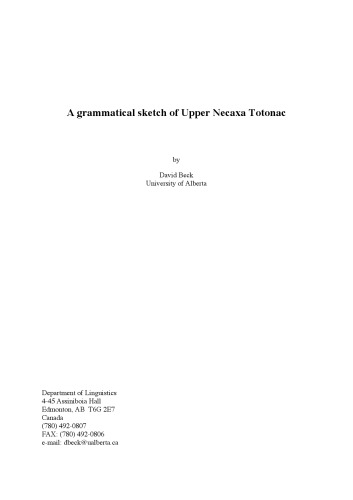

Most ebook files are in PDF format, so you can easily read them using various software such as Foxit Reader or directly on the Google Chrome browser.
Some ebook files are released by publishers in other formats such as .awz, .mobi, .epub, .fb2, etc. You may need to install specific software to read these formats on mobile/PC, such as Calibre.
Please read the tutorial at this link: https://ebookbell.com/faq
We offer FREE conversion to the popular formats you request; however, this may take some time. Therefore, right after payment, please email us, and we will try to provide the service as quickly as possible.
For some exceptional file formats or broken links (if any), please refrain from opening any disputes. Instead, email us first, and we will try to assist within a maximum of 6 hours.
EbookBell Team

4.1
10 reviews
ISBN 10: 3110238225
ISBN 13: 9783110238228
Author: David Beck
This grammatical sketch provides a detailed description of Upper Necaxa Totonac (UNT), an endangered polysynthetic language belonging to the Central Totonac branch of the Totonacan (Totonac-Tepehua) family, spoken by approximately 3,000-3,400 people primarily in the Sierra Norte of Puebla State, Mexico. As a previously undescribed language, UNT offers unique insights into Totonacan linguistic structures and Mesoamerican language typology.
The sketch covers the core aspects of UNT grammar, beginning with its phonology, including its segmental inventory (vowels and consonants, noting distinctive features like vowel length and laryngealization) and suprasegmental elements like stress. The morphology section delves into its highly agglutinative and polysynthetic nature, detailing the complex systems of nominal and, especially, verbal morphology. This includes discussion of intricate agreement patterns (person and number for subject and multiple objects), rich tense-aspect-modality (TAM) marking, diverse voice constructions, and extensive derivational processes, such as valency-changing affixes that function in lieu of prepositions to create complex verbal predicates with numerous arguments. Other notable morphological features like compounding and the affixation of partonymic prefixes to verbs are also explored. The syntax outlines basic clause structure, common word order patterns (often verb-initial, governed by information structure), and the structure of noun phrases and complex sentences, including the presence of both externally and internally-headed relative clauses.
The study also touches upon typologically interesting features such as its complex numeral classifier system, which categorizes nouns into distinct classes, and the inherent possession of body part and kinship nouns. Drawing on extensive field data, this sketch contributes significantly to the documentation of an under-researched language family and provides valuable empirical data for theoretical linguistics, particularly for studies on polysynthesis, grammatical relations, and Mesoamerican typology.
1. Introduction 1.1. The Upper Necaxa Totonac Language 1.1.1. Genetic Affiliation and Related Languages 1.1.2. Geographic Location and Speaker Population 1.1.3. Sociolinguistic Status and Language Vitality 1.2. Previous Research and Scholarship 1.3. Aims and Scope of this Sketch 1.4. Data Collection and Methodology 1.5. Orthography and Transcription Conventions
2. Phonology 2.1. Segmental Phonemes 2.1.1. Vowels 2.1.2. Consonants 2.2. Phonotactics 2.2.1. Syllable Structure 2.2.2. Consonant Clusters 2.3. Suprasegmental Features 2.3.1. Stress 2.3.2. Intonation 2.3.3. Tone (if applicable) 2.4. Phonological Processes 2.4.1. Assimilation 2.4.2. Dissimilation 2.4.3. Vowel Harmony (if applicable) 2.4.4. Reduplication
3. Morphology 3.1. Word Classes 3.1.1. Nouns 3.1.2. Verbs 3.1.3. Adjectives 3.1.4. Adverbs 3.1.5. Pronouns 3.1.6. Demonstratives 3.1.7. Prepositions/Postpositions 3.1.8. Conjunctions 3.1.9. Particles 3.2. Nominal Morphology 3.2.1. Pluralization 3.2.2. Possession 3.2.3. Derivational Morphology (e.g., nominalizers) 3.3. Verbal Morphology 3.3.1. Agreement (Person, Number) 3.3.2. Tense, Aspect, Modality (TAM) 3.3.3. Voice (Active, Passive, Middle, Causative, etc.) 3.3.4. Valency-changing operations (e.g., applicatives) 3.3.5. Derivational Morphology (e.g., verbalizers) 3.4. Other Morphological Processes 3.4.1. Compounding 3.4.2. Cliticization
4. Syntax 4.1. Basic Clause Structure 4.1.1. Word Order (e.g., SVO, SOV, VSO) 4.1.2. Argument Structure 4.2. Noun Phrase Structure 4.2.1. Head and Modifiers 4.2.2. Demonstratives and Quantifiers 4.2.3. Possessive Constructions 4.3. Verb Phrase Structure 4.4. Sentence Types 4.4.1. Declarative Sentences 4.4.2. Interrogative Sentences (Yes/No, Wh-questions) 4.4.3. Imperative Sentences 4.5. Complex Sentences 4.5.1. Coordination 4.5.2. Subordination (e.g., relative clauses, complement clauses, adverbial clauses) 4.6. Negation 4.7. Information Structure (e.g., Topic, Focus)
5. Semantics and Pragmatics (brief overview) 5.1. Core Semantic Domains (e.g., spatial relations, temporal expressions) 5.2. Speech Acts (e.g., requests, commands) 5.3. Deixis
6. Lexicon (brief overview) 6.1. Loanwords and Language Contact 6.2. Lexical Categories and Semantic Fields
7. Conclusion 7.1. Summary of Key Features 7.2. Directions for Future Research
a grammatical sketch of upper necaxa totonac
upper necaxa totonac
upper necaxa totonac dictionary
a grammar of tundra nenets
necaxa 1988
Tags: David Beck, grammatical, sketch